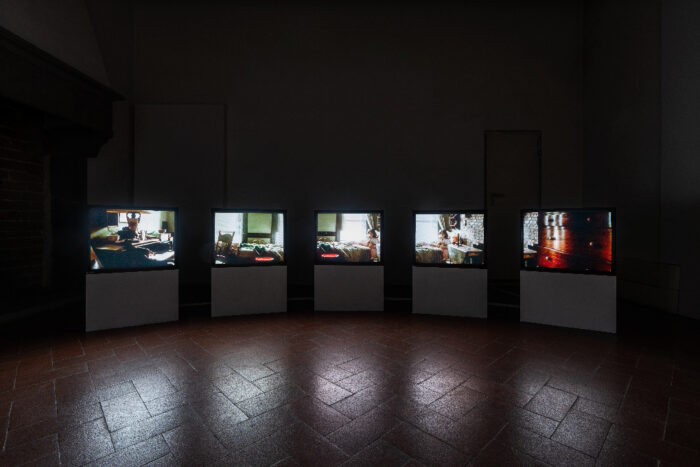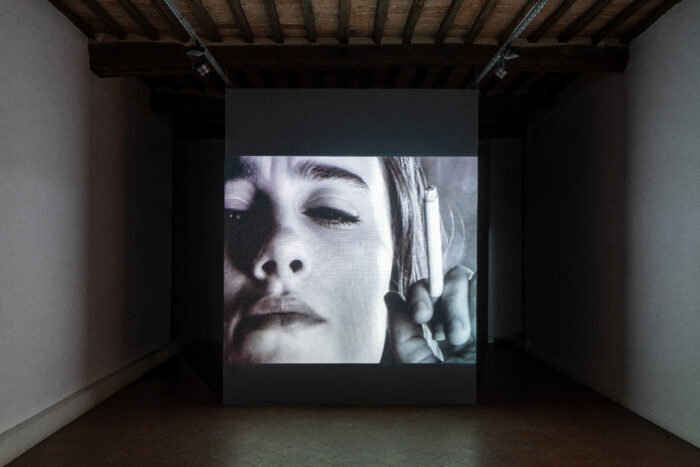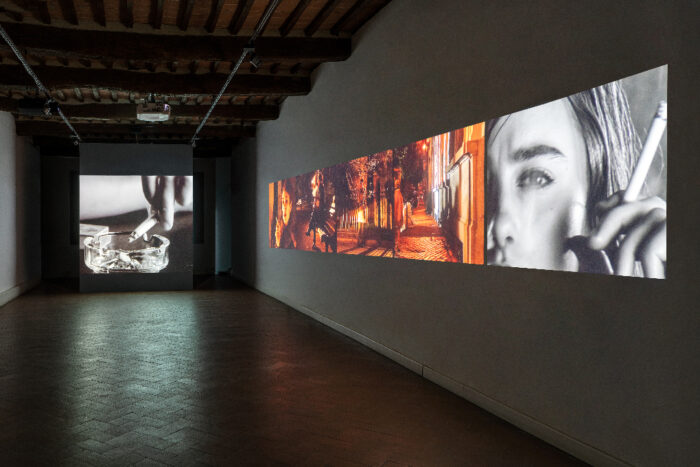A Dry and Moving Intensity
On Chantal Akerman films
This contribution was read by Ivone Margulies for the award ceremony of the Premio Marco Melani in memory of Chantal Akerman, on December 11, 2021, and a slightly different version was published as a tribute by Criterion. Curated by Rita Selvaggio, under the artistic direction of Claire Atherton and with Carole Billy, the exhibition STANZE. Sul custodire e il perdere is currently on view at Casa Masaccio | Centro per l’Arte Contemporanea.
I am pleased to pay tribute once again to Chantal Akerman, a person and artist of immense integrity and grace. After many years of involvement with her work, I can still remember the experience of watching Jeanne Dielman for the first time at New York’s erstwhile Metro Theater (in an impossible double bill with Céline and Julie Go Boating). Much later, during many classes devoted to her films I experience again and again, through my young students the intense aesthetic excitement at encountering work that is so perfectly bold.

My first piece on Akerman was called A Dry and Moving Intensity, words I believe apply still to her films and person. For what could better account for the filmmaker’s restless expressivity, her impatience with the comfort of a successful precedent, than moving, and what but dry intensity reflects the lasting imprint of her films, their memorable and slowly released emotion?
“And I left,” the first line in Je tu il elle proclaims already the creative escape possible as one moves inside one’s own room. Akerman’s strongest protagonists move on even as they attentively listen to demands to stay, as with Anna in Les rendez-vous d’Anna . Chantal’s identification with these characters’ fierce autonomy was conveyed invariably through a simple but stunning scene in which, in a solo or a duet, a woman stands up to sing off-key: dressed in a white towel robe in a modern hotel room, Anna sings an Edith Piaf ballad; in La captive Ariane sings in a duet with a woman from across her window (Così fan tutte); and at the start of Almayer’s Folly (2011), Nina solemnly faces us to sing Mozart’s “Ave verum corpus” in a karaoke bar. Defiant pride and quiet joy light up their countenances. They, as Akerman, move to their own beat.

Akerman was bold, direct, present, and funny. These qualities, apparent to all those who knew her, are alive in her films—in the frontal pressure of her shots and especially in her and her characters’ idiosyncratic timing.
Vertiginously moving across different genres and modes—tragedy, burlesque, slapstick, musical, the essay film, and documentary—she tested time’s elasticity and affect. And her timing, applied to gestures and pauses, was unerring. Chantal used to say she could feel when an image took, when it had force. She also knew when a shot should end. This intuition she shared with her friend and editor Claire Atherton, who knew how to cut according to her breathing. And it was indeed Akerman’s breathing, her attentive presence, that held us enthralled. Her obsessively replayed themes—possessiveness versus autonomy, anxiety and boredom, the silences and sonorities of her personal Jewish history—bore through her austere, strikingly clear images.

When she wanted to break away from the structural mastery of Jeanne Dielman, she made musicals and comedies, genres that thrive on incongruity and failure. And when Chantal herself appeared in these films, a manic, excessive animation energized her mise-en-scène: she conducts Noël’s singing in The Eighties with a matching, frantic gesticulation; she mocks her image as a long, slow filmmaker by speeding up and slurring her lines in Lettre d’un cinéaste(1984); in “Sloth”, she takes her vitamin pills in one gulp to counter her procrastination. Such overstated compressions became Akerman’s signature, a set of themes and strategies she drew on each time she felt the need to offset her minimalist sobriety.
Chantal loved singing. Already in Saute ma ville (1968), her first film, she alternates the sounds of sealing her door with Scotch tape with a crunchy bite of her apple, making music that links drama to the everyday. And when two young women stroll in Paris and suddenly swerve, stopping for rhymed pronouncements—“I am cold,” “I am hungry”—we delight in detecting the double beat of repetition and difference that structures her films.

Akerman’s penchant for stories told and retold, for the cyclical circulation of jokes and old sayings—in Histoires d’Amérique and elsewhere—tells us something of this sensibility for the subtle twist, the small variation. In Toute une nuit (1982), her ebullient ode to romantic love, characters of all ages couple and decouple in short bursts of longing, sexual desire, and boredom. Gestures stretch between lassitude and impulsivity, and bumping bodies morph into impossibly long and passionate dances to schmaltzy music. Clichés are never banal in Akerman’s films because they insist on what needs repeating. Her entire work is attuned to the singularity that pulses through domestic routines, to particular ways of making love or of waiting in line.
After what would be her last film, No Home Movie, Akerman remarked she did not think she could go back to the type of filming she did before: “Most of my films were touching on people but not in such a direct way…they were more into implosion than explosion.” As the director films in her mother’s apartment, returning to the matrix of all of her films’ interiors, she embraces the directness of the home movie form to redesign analogues for the intricate relationship of symbiosis and distance between herself and her mother.

The affective map managed by Chantal Akerman, the person and the artist, had always involved a tension between abstract evocation and concrete dailyness, between charged silences and deeply felt and expressed emotions. Thus, the film’s emotional immediacy has to be understood alongside the filmmaker’s characteristic indirection, the kitchen talks along with the desert shots.
The conversations with her mother in particular are strikingly elemental, providing another register by which to grasp the artist’s transmutation of personal life into her films’ overlong and redundant dialogues. Here, in her last film, we actually hear the impossibly stretched and repeated goodbyes and terms of endearment that so elegantly hang over News from Home. At the kitchen table, Chantal spouts cliches to her mother as if to a child: “meat is protein, it builds muscles . . . the potato skin has vitamins.” She mouths Hebrew blessings with her mother to test “her” memory. That such simple exchanges happen within this apartment, the locus of all of Akerman’s ruminative thoughts, confirms this film’s astonishing accomplishment: to return to the source of one’s art, to maintain its everyday integrity, and to shape still yet another perfect film.

Addressing her ruminative approach, Akerman once asked rhetorically: “Is it because we saw something already that we think we don’t need to see it any longer? On the contrary, when we show something everyone has seen, it is perhaps at that point we see if for the first time. The woman, her back to us, pulls out potatoes, Delphine, my mother, yourself. A woman, yes, but a corridor for a minute? A tree?”
Akerman took on the challenge of looking again to see for the first time, and she explored the uncanny undercurrents of the familiar. Her rounded dialogues reproduced the monotone litany of the prayers she heard as child at the synagogue. And while all her films are infused with familiar cadences, comforting and suffocating, she modulated this hush into art with an exacting formal and emotional logic. In News from Home, she echoes her mother’s letters as the film dispatches her loving words out into the world: “My darling, I live to the rhythm of your letters.”
Averse to stridency and manifestos, Akerman was drawn toward what Deleuze and Guattari called minor expressions, to letters, songs, and jokes. The letters frequently crossing her oeuvre speak of her search for the resonances between her own personal history and other current plights and displacements. One of the most poignant of these letters is read at an impromptu gathering around a table in From the Other Side (2002). After meeting some Mexicans who have been abandoned in the middle of their attempt to cross the border, Akerman invites them for a meal. In thanks, they read a collectively signed letter to the camera. It is to this table, a banquet of expressive words and images, elicited through Akerman’s attentive listening, that we are invited and gather each time we continue to watch her moving films.





